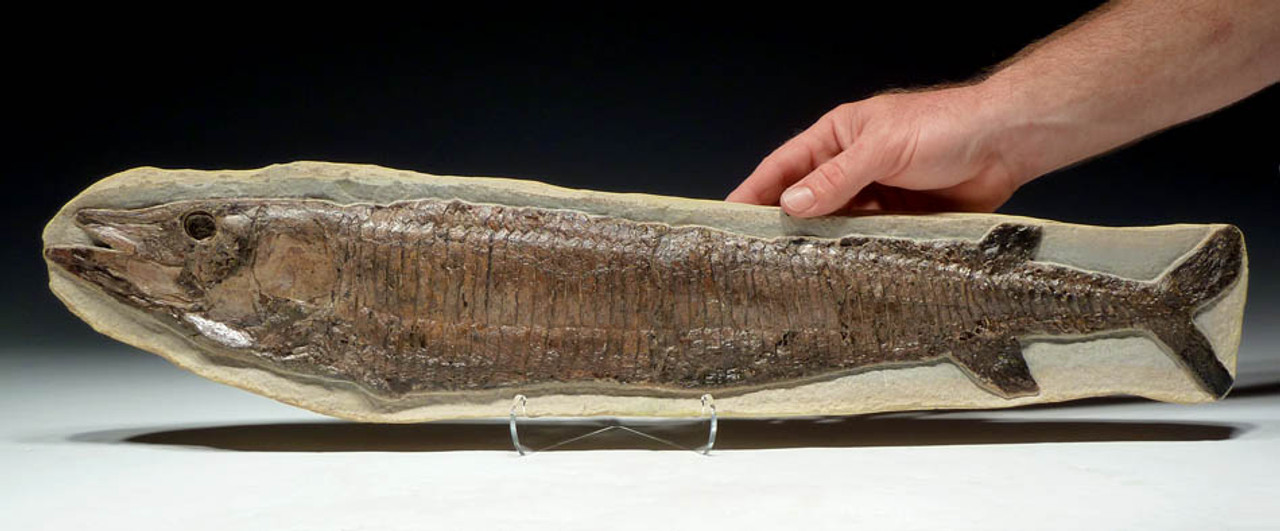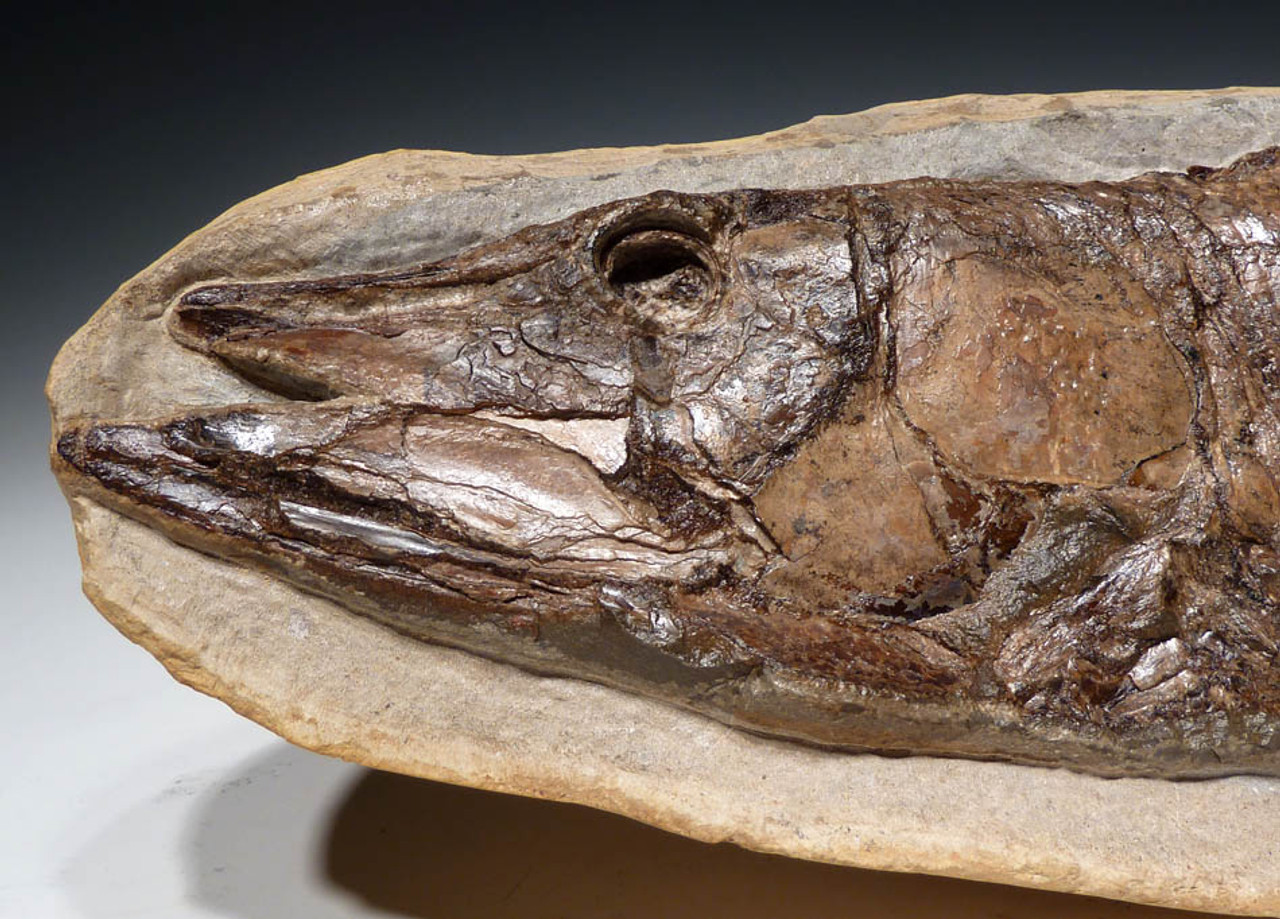Product Description
This fish fossil is THE FINEST SPECIMEN OF THIS SPECIES WE HAVE EVER SEEN. It is of the species Vinctifer. Nearly every concretionary Brazil fossil on the market and in museums is of the Jardim or Santana type. This can be seen by the beige to cream color of the concretion and the light brown to gold color of the fossils. Old Mission concretions are harder and the rock in the core is dark gray or olive with the fossils being much darker. The lithology of Old Mission concretions is also one of a much harder substance. Because of this, the Old Mission concretions yield much better preserved fossils and ones that are very dark in color ranging in many cases, from dark brown to black. We have not seen any true Old Mission concretion fossils on the market in years. Perhaps it is because the deposit has long since been over-collected of these type concretions. This specimen comes from the "Old Mission" region of the formation and it shows such incredible and well-detailed preservation, we can easily say this is the finest and most beautiful example of this fish we have ever seen in any museum or publication.
This fish was a member of the ASPIDORHYNCHID family, a highly specialized extinct group that lived from the Middle Jurassic Period 160 million years ago to the end of the Cretaceous Period 65 million years ago. Based on their long, torpedo-like design and fin anatomy and location, they were likely very swift hunters much like a modern barracuda is today. One of their most obvious anatomical features is their long, rectangular enameloid scales running all down their body. This specimen possesses complete and full preservation with very high three-dimensional relief. The scale detail is impeccable with a rare dark color pattern to the fins and delicate dorsal and ventral body scales. How it took this pattern is most likely based on the colored mineralization of the possibly denser scales in these regions. It is an uncommon and beautiful feature we don't see often in any fossil fish of any formation. The amazing preservation and state of this specimen can be compared to the American Museum's specimens seen on page 176-177 of Maisey's publication. The museum specimens greatly lack in the quality of preservation when compared this this complete specimen offered for sale. Vinctifer is classified by curator Maisey as a RARE fish yet several specimens can sometimes be found in the market. This is a VERY popular fish to fake or build from parts of multiple fish and many "junk" examples populate the commercial fossil market from time to time. Finding a 100% COMPLETE AND 100% AUTHENTIC specimen like this, is RARE. Even the American Museum of Natural history specimens are lacking in the quality of this specific Vinctifer we are offering here! The full, lifelike relief throughout of this amazing specimen must be seen in person to appreciate.
We received this remarkable specimen in an un-prepared state and performed all the time-intensive lab work in our own facility. The result is preservation and anatomy shown that is seldom seen. Even the sclerotic ring in the eye has been exposed in full form! The teeth would be hidden below the jaw because of the distended throat indicating the mandible and maxilla bones are stretched over the teeth. EVERY part of this fish is original and there the different types of scales on the back, tail, sides and belly can be seen in perfectly preserved form.
HISTORY
Of all the richest fossil-bearing deposits ever known, Brazil's Santana Formation is ranked among the world's greatest. Santana fossils are known for not only their extreme diversity but more importantly, for the nature of their breath-taking preservation - considered by scientists to include the finest examples of fossils in existence. The formation provides an amazing window into the paleobiota of a prehistoric world from the Lower Cretaceous, 110 million years ago. The Santana fossils of Brazil were first recorded in the year 1828 by two natural historians, Dr. J. B. von Spix and Dr. C. F. P. von Martius, commissioned by the king of Bavaria. To this day, they are still being studied with many new discoveries coming to light.
In John Maisey's book titled "Santana Fossils", he cites the prevalence of fake, composite and enhanced fossils from this formation that are on the market. The local artisans at the sites produce a wide variety of artificially created fossils - some horribly obvious yet some, extremely convincing out of carefully matched composite pieces. These composite examples are very convincing because they are made up of all real pieces but not necessarily of the same species! Often, missing parts are carved or sculpted from a mixture of plaster, rock dust and epoxy and then painted to disguise the work. A number of these handcrafted "fossils" have in the past, and continue to, make it into the mainstream fossil market. Describing a variety of techniques and types of fakes, Maisey even shows photographs of some fakes for reference to illustrate the breadth, creativity and skill of some of these workers. He also addresses the prevalence of fake insect and other rare fossils within the text. With all Brazilian fossils, collectors should approach prospective purchases with caution for not only the legality of the specimen but also, for accurate disclosure by a qualified and experienced preparator of any artificial enhancement to the specimen.
 US DOLLAR
US DOLLAR
 EURO
EURO
 AUSTRALIAN DOLLAR
AUSTRALIAN DOLLAR
 CANADIAN DOLLAR
CANADIAN DOLLAR
 POUND STERLING
POUND STERLING






























